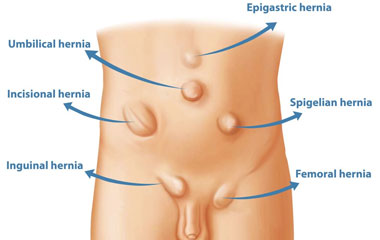hemalbhagat@hotmail.com
Get a Consultation
It is the protrusion (bulge) of abdominal viscera through a weakened part of abdominal wall. A hernia does not get better over time, nor will it go away by itself (except very small congenital navel hernia). It always becomes bigger with time.

The common types of hernias are present in the groin (inguinal), belly button (umbilical and the site of a previous operation (incisional). There are many more types but are rare.
Hernia is easy to recognise. It appears as a bulge under the skin. This bulge may appear on standing or straining and disappear on lying down. It may or may not be painful. Discomfort may worsen at the end of the day and also while coughing and sneezing.
Surgery is the only cure for majority of hernias. There is no medical treatment for it.
Once detected, for best results, the hernia should be treated as early as possible. Also, early operation will prevent complications like obstruction and strangulation. When compared with large hernias, the surgical results with smaller hernias are much more satisfying.
Strangulation of hernia is a surgical emergency. The hernia becomes very painful, does not reduce and the overlying skin becomes red. The patient will require hospitalisation and immediate surgery.
The types of surgery available for treating hernias are: a) Laparoscopic surgery also known as Minimal Access Surgery / Minimally Invasive Surgery / Laparoscopic Surgery.
Three (5-5-10 mm sized) incisions are made and cannulas placed in them. A laparoscope (a long narrow telescope) connected to a special camera is inserted through a cannula (a small hollow tube), allowing the surgeon to view the hernia and surrounding area on a video screen. Other cannulas are inserted which allow the surgeon to work “inside'. A piece of surgical mesh is fixed over the hernia defect and held in place with small surgical tackers.
Laparoscopic surgery causes much less pain and patients are mobile within hours after surgery. In laparoscopic surgery both sides can be operated in the same sitting without any extra pain or stay. The cosmetic results are excellent.
Yes. Now world over, there is consensus that the use of mesh is desirable in majority of patients to strengthen the wall whether surgery is done conventionally or laparoscopically. Only the childhood hernias are repaired without using mesh.
Yes. Done by a properly trained surgeon in a well equipped centre, it is safe surgery with excellent results.
Patients are admitted in the hospital on the day of surgery or a day prior to surgery. On admission, patients are examined and investigations reviewed by one of the team members. A member of the Anaesthesia Team conducts the pre-anaesthetic check-up, Pre-operative investigations are performed if needed. Patients need to be fasting overnight before the surgery. Next morning, he/she will be shifted to the operation theatre half an hour prior to surgery. After surgery, they are shifted to the recovery room for 2-4 hours under the care and supervision of our Anaesthesia Team for observation and then shifted back to the room. It takes about 4-8 hours before the patient comes back to his/her room. Patient is given sips of water orally on returning to the room and progresses to drinking all liquids on the same evening as surgery. They may sit up, visit the toilet and move around for a few hours after surgery and are encouraged to do so early.
Patients are given a normal breakfast next morning and discharged from hospital after a visit by one of the team members. On discharge, a discharge summary with the advised medication is handed over to the patient.
It can be done via open surgery and laproscopic surgery
Both procedures are good, both procedures have its pro & cons. It has to be customized according to the safety of the patient. It always better for the patient that a surgeon decides what is a safe surgery for the patient.